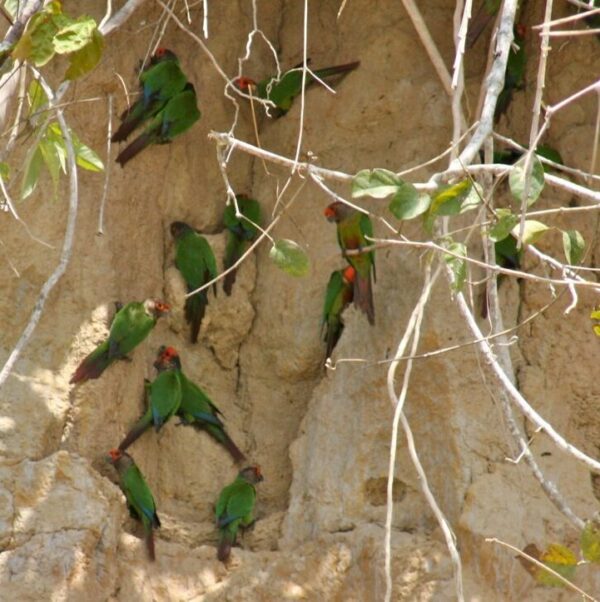Rose-fronted Conure
Also known as:
Rose-fronted Parakeet, Red-crowned Conure or Parakeet
Also known as:
Rose-fronted Parakeet, Red-crowned Conure or Parakeet

Pyrrhura

roseifrons
Size:
22 cm (8.6 in)
Weight:
54-70 g (1.9-2.5 oz)
Subspecies including nominate:
one
Colour Adult:
Both adults partly green; rose/red forehead and face; maroon/brown lower cheeks; pale yellow ear coverts; dull green/brown breast scalloped with green/yellow; red bend of wing and carpal edge; brown/maroon patch on abdomen; brown/red tail becoming green at base. Beak dark grey. Eye ring bare and cream/white. Eye brown.
Colour Juvenile:
Dark maroon/brown forehead and face; buff/white ear coverts; grey/green upper breast scalloped with yellow/green; green lower breast; green bend of wing and carpal edge; brown/red patch on abdomen less evident; shorter tail.
Call:
Calls made in flight are coarse and forceful staccato notes.
More Information:
Content Sources:
BirdLife International
Cornell Lab of Ornithology/Birds of the World
A Guide to Parrots of the World, Juniper and Parr, 1998
Parrots of the World, Forshaw, 2006. 2010 edition
Parrots in Aviculture, Low, 1992.
Lexicon of Parrots, Thomas Arndt.
Captive Status:
Uncommon.
Longevity:
Probably 13-15 yrs.
Housing:
As for P. picta: aviary or suspended enclosure, minimum length 2 m (6.5 ft).
Diet:
As in P. picta: Fruits such as: apple, pear, oranges, bananas, cactus fruits, pomegranate, kiwi, papaya, forming about 30 percent of the diet; vegetables such as: carrot, celery, green beans and peas in the pod; fresh corn; green leaves such as: Swiss chard, lettuce, sowthistle, kale, dandelion, chickweed; spray millet; small seed mix such as: canary, millet and smaller amounts of oats, buckwheat, safflower and a little hemp; soaked or sprouted sunflower seed; cooked beans and pulses, boiled maize and complete kibble.
Enrichment:
Vigorous chewers so provide bird-safe, unsprayed flowering, fir, pine, willow or elder branches; wooden block or vegetable tanned leather chew toys, heat sterilized pine cones. Also provide overhead misters or shallow bowls of water for bathing.
Nest Box Size:
As for P. picta: vertical box 8″ x 8″ x 28″ (20.3 cm x 20.3 cm x 71.1 cm).
Clutch Size:
Probably 5-7.
Fledging Age:
About 40-51 days.
Hatch Weight:
—
Peak Weight:
—
Weaning Weight:
—
World Population:
Unknown, decreasing.
IUCN Red List Status:
Least Concern
CITES Listing:
Appendix II
As conspecific with Pyrrhura picta.
Threat Summary:
This species is at threat from trapping for the wild bird trade, hunting and habitat loss. Its global population size is unknown given recent taxonomic splits. This species is considered to have a medium dependency on forest habitat, and tree cover is estimated to have declined by 3.3% in its range over the past 10 years. As a precautionary measure, it is tentatively suspected that forest loss may have led to a 1-19% decline in the species’ population over the same period.
Range:
W Amazonia from N Brazil and NE Peru south to N Bolivia.
Habitat:
Found up to 1200 m (3936 ft) in humid forest in foothills and in lowland terra firme and varzea forests; also in margins and adjacent clearings with tall trees. Seen in stunted forest along riverways with large bamboo patches.
Wild Diet:
Probably fruits, berries, seeds, buds, shoots and insects and their larvae.
Ecology and Behaviour:
Seen in groups of up to 15 birds; inconspicuous while feeding or resting. Otherwise noisy and active in flight through or above forest canopy.
Clutch and Egg Size:
Probably 5-7 eggs, 25.5 x 19.0 mm (1 x 0.7 in).
Breeding Season:
Probably July-December. Nest is in tree cavity.

![© Alex Lee [CC BY 2.0] Wikimedia Commons Wild Rose-fronted Conures take soil at a clay lick](https://parrots.org/wp-content/uploads/1990/11/Rose-fronted-Conure-Alex-Lee-from-Miami-Fl-USA-CC-BY-2.0-via-Wikimedia-Commons-e1732745133907-100x100.jpg)